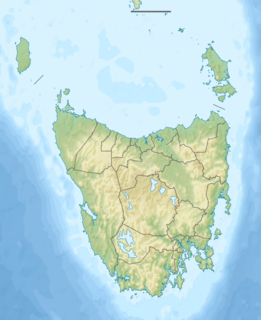
Catonephele is a nymphalid butterfly genus found in Mexico, Central America, South America, and the West Indies.

Catonephele orites, the orange-banded shoemaker butterfly, is a species of butterfly found throughout the northern coast of South America and into Central America.

The Sticht Range is a mountain range located in the West Coast region of Tasmania, Australia. The range runs between two tributaries of the Eldon River and is located within the eastern part of the West Coast Range and has an unnamed peak with an elevation of 1,080 metres (3,540 ft) above sea level.

Orites excelsus, commonly known as prickly ash, mountain silky oak or white beefwood, is a species of flowering plant in the family Proteaceae and is endemic to eastern Australia. It is a medium-sized to tall rainforest tree with oblong to lance-shaped leaves, variously lobed and with teeth on the edges. The flowers are white and arranged in leaf axils in spikes that are shorter than the leaves.

Orites is a genus of 9 known species, 7 endemic to Australia and 2 in South America; 1 in the Chilean Andes and 1 in Bolivia.
Eugenia orites is a species of plant in the family Myrtaceae, the myrtles. It is a tree endemic to Peninsular Malaysia. It is threatened by habitat loss.

Isopogon ceratophyllus, commonly known as the horny cone-bush or wild Irishman, is a plant of the family Proteaceae that is endemic to the coast in Victoria, South Australia and on the Furneaux Group of islands in Tasmania. It is a small woody shrub that grows to 100 cm high with prickly foliage. It is extremely sensitive to dieback from the pathogen Phytophthora cinnamomi

Orites lancifolius, commonly known as alpine orites, is a shrub in the family Proteaceae. It is endemic to south-eastern Australia. The species has a spreading habit and may be a prostrate or up to 2 metres high. The leaves are 1 to 3 cm long, and 5 to 12 mm wide. White to pale yellow flowers appear between December and January in its native range. The species was first formally described in 1855 by botanist Ferdinand von Mueller from plant material that he collected "on the rocky summits of the Australian Alps ".

Orites myrtoidea , the radal enano, is a shrub species in the family Proteaceae. It is a rare plant which occurs in lava fields in the Andes in Chile. The species may grow up to 2 metres high, but more often is in the range of 0.5 to 1 metre. The leaves are about 3 cm long, and 10 mm wide. White to yellowish flowers appear in compact racemes between October and November in its native range. These are followed in autumn with reddish brown fruits containing winged seeds.

Ceratophyllus gallinae, known as the hen flea in Europe or the European chicken flea elsewhere, is an ectoparasite of birds. This flea was first described by the German botanist and entomologist Franz von Paula Schrank in 1803.

Orites revolutus , also known as narrow-leaf orites, is a Tasmanian endemic plant species in the family Proteaceae. Scottish botanist Robert Brown formally described the species in Transactions of the Linnean Society of London in 1810 from a specimen collected at Lake St Clair. Abundant in alpine and subalpine heath, it is a small to medium shrub 0.5 to 1.5 m tall, with relatively small, blunt leaves with strongly revolute margins. The white flowers grow on terminal spikes during summer. Being proteaceaous, O. revolutus is likely to provide a substantial food source for nectivorous animal species within its range.
Neorites is a genus of a sole described species of tall tree in the family Proteaceae. The species Neorites kevedianus, commonly called fishtail oak or fishtail silky oak, is endemic to the wet tropics rainforests of north eastern Queensland, Australia.
Sphalmium is a monotypic genus of flowering plants in the protea family. The only species, Sphalmium racemosum, is a large forest tree. Common names include satin silky oak, mystery oak, Mt Lewis oak, poorman's fishtail oak and buff silky oak.
Nothorites is a genus of a sole described species of trees, constituting part of the plant family Proteaceae. The species Nothorites megacarpus grows naturally only in restricted mountain regions (endemic) of the wet tropics rain forests of north-eastern Queensland, Australia.

Ceratophyllus is a widespread genus of fleas found in temperate climates. Some of its members include the chicken flea, Ceratophyllus gallinae, and the poultry flea, Ceratophyllus niger.

Orites diversifolia (=diversifolius), commonly known as variable orites, is a member of the family Proteaceae and is endemic to Tasmania. The common name stems from the variable form of the leaves, which range from entire and linear to serrated and ovate. It is a common shrub in lowland rainforest, subalpine woodland and scrub.

Orites acicularis, commonly known as yellow bush, is an angiosperm endemic to Tasmania, Australia and is a member of the genus Orites within the family Proteaceae. The species was first described in 1810 by Scottish botanist Robert Brown in Transactions of the Linnean Society of London.
Orites milliganii, also known as Milligan’s orites or the toothed orites, is a species of flowering plant in the protea family that is endemic to Tasmania, Australia.
Orites fiebrigii is a species of flowering plant in the protea family that is endemic to Bolivia.
Carniella orites is a species of comb-footed spider in the family Theridiidae. It is found in Thailand.










